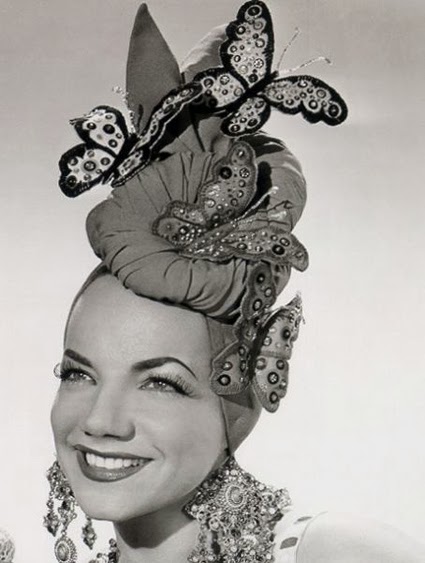Date of Death
5 August
1955
, Beverly Hills, Los Angeles, California, USA
(heart attack)
After leaving school, Carmen got a job at a local store, and often began singing on the job. Before long she was discovered and got a singing job on a local radio station. She ultimately got a recording contract with RCA. By 1928 she was a genuine superstar in Brazil.
As with other popular singers of the era, she eventually made her way into the film world. She made her debut in the Brazilian documentary A Voz do Carnaval (1933). Two years later she appeared in her first feature film, Alô, Alô, Brasil (1935).
However. it was Estudantes (1935) that seemed to solidify Carmen in the minds of the Brazilian movie audiences. Now they realized she could act as well as sing. Although there was three years between "Alo, Alo Carnaval" and Banana-da-Terra (1939), Carmen continued to churn out musical hits in Brazil.
The latter film would be the last in her home country. In late 1939 Carmen arrived, with much fanfare in the press, in New York City. She was now ready to capture Americans' hearts with her talent. She appeared in some musical revues on Broadway and, just as everyone thought, was a huge hit.
In 1940 Carmen was signed to appear in the Twentieth Century-Fox production Serenata argentina (1940), with Betty Grable and Don Ameche. The only complaint that critics had was the fact that Carmen was not on the screen enough. In 1941 she was, again, teamed with Ameche in addition to Alice Faye in That Night in Rio (1941). The film was extremely popular with the theater patrons.
Her unique songs went a long way in making her popular. It was after A La Habana me voy (1941) that American cartoon artists began to cash in on Carmen's ever-growing popularity. In the 1930s and 1940s cartoons were sometimes shown as a prelude to whatever feature film was showing.
Sure enough, the cartoon version of Carmen came wriggling across the screen, complete with her trademark fruit hat and wide, toothy grin. In 1942 Carmen starred in Secretaria brasileña (1942) with Betty Grable and Cesar Romero, both of whom she had worked with before. It was shortly after this that America began adopting her style of dress as the latest fad.
1944 saw her in three films: Something for the Boys (1944), Four Jills in a Jeep (1944) and Greenwich Village (1944). The first two did well at the box-office, but the last one left a lot to be desired. It was her last busy year in film. Carmen made one film each in 1945, '46, '47 and '48. After that she didn't make a film for two years, until Nancy va a Rio (1950), a production for MGM.
Once again didn't make a film for several years, returning with Una herencia de miedo (1953). She did stay busy, singing on the nightclub circuit and appearing on the relatively new medium of television. However, "Scared Stiff" was her final performance on the silver screen. On August 4, 1955, she suffered a heart attack, although she didn't realize it at the time, during a live broadcast of The Jimmy Durante Show (1954).
She went home after attending a party (she neither drank or smoked). Early the next morning, on August 5, Carmen suffered a fatal heart attack. She was just 46 years old. Her body was flown to her adopted country of Brazil, where her death was declared a period of national mourning.
Was best known for her musical numbers where she wore a costume featuring a hat decorated with fruit.
Portuguese accent
High cheek bones
Enthusiastic personality
The intersection of Hollywood Bl. and Orange Drive, was named Carmen Miranda Square. [September 1998]
In the 40s she was the highest paid star/ performer in the USA.
The "Lady with the Tutti-Frutti Hat" in Hollywood musicals of the
1940s. See her at her sparkling best as the cheeky "Rosita Murphy" in
the gorgeous Technicolor Secretaria brasileña
(1942), in which, without the slightest effort, she virtually steals
every scene she's in - upstaging even the film's [nominal] star, Betty Grable!
She appeared in the 1939 Broadway revue, "Streets of Paris", in which she introduced the song "South American Way".
Sister of actress Aurora Miranda (b.1915), Olinda (b.1907), Amaro (b.1911), Cecília (b.1913) and Oscar (b.1916).
She was the subject of a Jimmy Buffett song called, "They Don't Dance Like Carmen No More"
Carmen Miranda, or rather her ghost, is the subject of a song by
Leslie Fish called "Carmen Miranda's ghost is haunting Space Station
Three". There is also a book by that name, containing a collection of
short stories. The only connection between the stories is that each have
to do with the title.
Her contract with 20th Century Fox specified that there would be
no cutting away from her to reaction shots and/or dialog from other
players while her musical numbers were in progress.
Daughter of José Maria Pinto da Cunha (1887-1938) and Maria Emília Miranda (1886-1971).
Mother Maria Emilia Miranda 1886-1971.
Pictured on one of five nondenominated USA commemorative stamps
honoring Latin Music Legends, issued on 16 March 2011; price on day of
issue was 44¢. The other stamps honored Tito Puente, Selena, Carlos Gardel, and Celia Cruz.
Although born in Portugal, considered herself Brazilian at heart.----------- ----------- -----------
Follow @OFFmagacine








































































-9.jpg)








